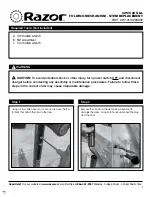
Monarch GC340 / 440 Owner’s Manual. © Scooters Australia 2010
-13
.
20
Remedy: Recharge your scooter’s batteries. See “Charger and Batteries” in this section of
this manual.
1. If the problem continues, have your authorized Scooters Australia dealer load test the
batteries.
2. If the batteries are good, the charger may be the problem. Consult your authorised
dealer.
Resetting the Main Circuit Breaker
•
If the main circuit breaker trips as a result of run-down batteries or because of a
temporary overload, reset the circuit breaker:
•
Wait ten minutes or so for the motor control board to return to the normal operating
temperature range.
•
Make certain that the key switch is set to the “Off” position.
•
Press in on the main circuit breaker reset button. See Fig. 22.
•
NOTE: If the main circuit breaker continues to trip, there is probably an underlying electrical
fault that needs attention
.
Contact your authorised dealer
.
WARNING: Do not keep resetting the main circuit breaker without correcting the underlying
electrical problem.
DIAGNOSTICS
The diagnostics feature of your scooter’s microprocessor based motor control board functions
as follows:
•
Any fault condition on the controller or on an associated system will cause the Power
Indicator LED to flash.
•
The flashing of the LED occurs as one flash or as a series of flashes separated by a
two second pause.
•
The number of flashes in each series is referred to as the “Flash Code.”
•
The flash code indicates the nature of the condition or fault – see below
The Flash Codes
1 Flash:
Indicates that the battery voltage (with the throttle control lever in the neutral position) is
below 19 volts. The batteries need to be charged. Your scooter will continue to operate
at reduced speeds until the voltage falls to 17.5 volts. As the voltage drops you will
experience a power loss.
Remedy: Charge your scooter’s batteries. See “Batteries and Charging” in this section.
2 Flashes:
Indicates that the battery voltage has dropped to 17.5 volts. At this voltage your scooter
will cease operation. If you have charged the batteries and the condition continues, one
or both of the scooter’s batteries may be at fault. The continuance of this condition after
you have charged your scooter’s batteries may also indicate a problem with the battery
charger.
3 Flashes
Consult your authorised dealer.
4 Flashes
Indicates that the motor control board is overloaded and overheated. An overload can
occur if you have been driving your scooter for an extended period of time up an incline
that is steeper than the recommended grade (see “Specifications” on page 22). An
overload can occur if your scooter is carrying a payload that is higher then the
recommended weight capacity. See “Specifications” on page 22 for your scooter’s
weight capacity. If your scooter is equipped with pneumatic tyres and they are
underinflated, an overload can also occur. Underinflated tyres cause the motor to draw
large amounts of current. This high draw overheats the motor control board. Your
scooter will not operate until the motor control board cools back to its operational
temperature range.
Summary of Contents for GC 340
Page 1: ......
Page 26: ...Authorised Dealer...







































